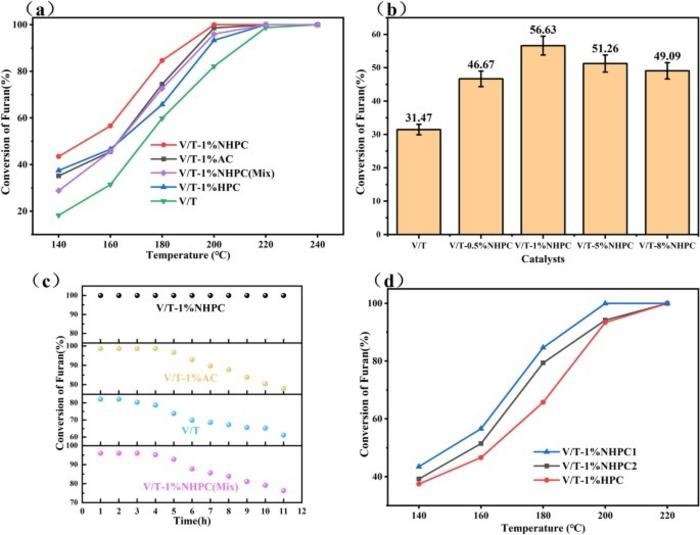Researchers have made significant strides in the field of environmental pollution mitigation by improving the effectiveness of vanadium-based catalysts through nitrogen-doped biomass carbon for the degradation of furan at lower temperatures. This approach will not only provide a more efficient way of breaking down harmful pollutants but will also represent a significant step towards more sustainable and cost-effective environmental protection measures.

Graphical abstract. a The furan removal efficiency of various catalysts, b catalytic oxidation of furan on catalysts with different NHPC adding at 160 °C. HPC Hierarchical porous carbon, AC active carbon, NHPC N-doped hierarchical porous carbon, c On-stream reaction time over samples at 200 °C with GV=8000 mL g-1 h-1, d Comparative activity test of catalysts with NHPC and HPC combining, catalytic performance of furan on V/T1%NHPC1, V/T-1%NHPC2, and V/T-1%HPC. Image Credit: Waste Disposal & Sustainable Energy
Dibenzofurans and polychlorinated dibenzo-p-dioxins are hazardous pollutants due to their environmental persistence and carcinogenicity, and the conventional catalytic oxidation techniques that are used to eliminate these pollutants come with their own drawbacks, such as high cost and poor performance at lower temperatures.
Studies have indicated that the utilization of carbon-based materials, including carbon nanotubes and active carbons, enhances catalytic performance by augmenting the adsorption and dispersion of active sites.
Nevertheless, maintenance problems and expense constraints restrict their use. Due to their large surface area and porosity, N-doped carbon materials made from biomass present a feasible substitute that could lower operating temperatures and boost efficiency.
A catalyst including nitrogen-doped biomass carbon (NHPC) and vanadium-based components is presented by Zhejiang University researchers in a study that was published on December 21st, 2023, in Waste Disposal & Sustainable Energy.
This discovery significantly boosts furan’s low-temperature degradation activity and provides a fresh approach for the effective breakdown of persistent organic contaminants, which represents a major advancement in environmental remediation efforts.
In this study, researchers developed a series of vanadium-based catalysts. Their catalytic performances were significantly enhanced by nitrogen-doped hierarchical porous carbon (NHPC) derived from biomass. This led to a marked improvement in the degradation of furan, a persistent organic pollutant, at lower temperatures.
The addition of NHPC to the catalyst structure enhanced the uniform distribution of vanadium oxide phases and allowed for a rise in active sites—two critical components of the catalytic process. The improved catalyst outperformed conventional catalysts by achieving 50% furan conversion at 150 °C; full conversion took place at 200 °C.
This breakthrough not only enhances the efficiency of furan degradation at significantly lower temperatures but also opens new pathways for sustainable environmental remediation techniques.
Dr. Minghui Tang, Study Lead Researcher, Zhejiang University
The application of N-doped Hierarchical Porous Carbon (NHPC) in catalysts represents a major development in environmental technology, offering a low-temperature, cost-effective method for hazardous pollutant removal.
This innovation not only raises the bar for pollution control but also highlights the potential of carbon materials obtained from biomass in catalytic degradation, increasing the effectiveness of pollutant degradation and promoting long-term environmental protection strategies.
The National Natural Science Foundation of China (No. 52006191) and the Natural Science Foundation of Zhejiang Province (No. LY21E060007) funded the study.
Journal Reference:
Wang, L., et. al. (2024) Enhancing mechanisms of N-doped biomass carbon on the vanadium-based catalyst for furan degradation at low temperature. Waste Disposal & Sustainable Energy. doi:10.1007/s42768-023-00172-0